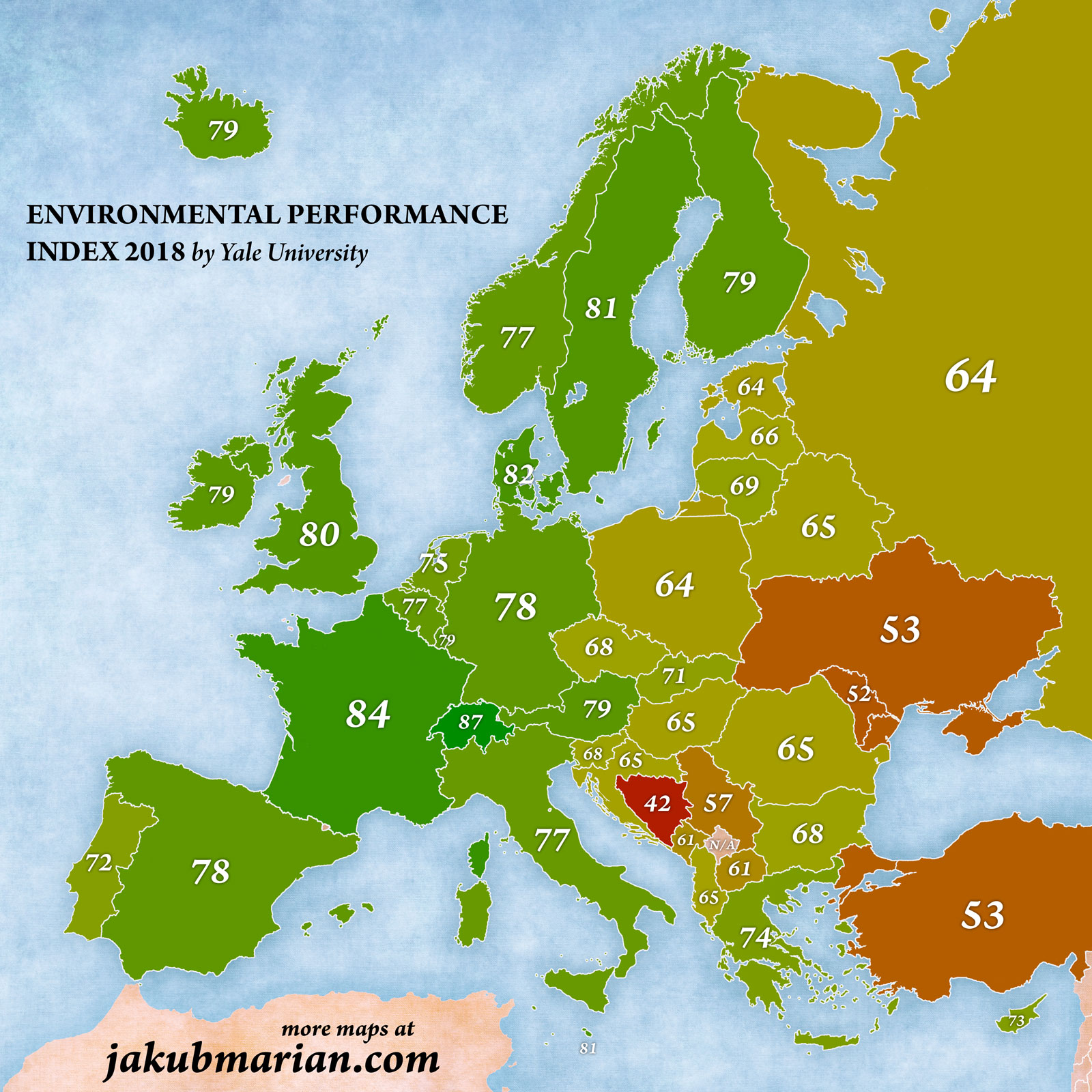Ekologija

- Posts : 11764
Join date : 2014-10-27
Location : kraljevski vinogradi
- Post n°176
 Re: Ekologija
Re: Ekologija
Izgleda zabrinjavajuće.
_____
Ha rendelkezésre áll a szükséges pénz, a vége általában jó.

- Korisnik

- Posts : 4670
Join date : 2015-02-17
- Post n°177
 Re: Ekologija
Re: Ekologija
Da li se vrućina vraća u naš grad
Leto u Beogradu kao u Alepu
Gradovi su posebno osetljiva mesta klimatskih kriza. Sve toplija leta u budućnosti će posebno pogađati gradove (čak i do 7,8°C više od zelenijih ruralnih predela) kao urbana toplotna ostrva. Veće zagrevanja gradova od okoline nastaje kao efekat dnevnog akumuliranja toplote i njenog noćnog oslobađanja iz ne-zelenih površina, zbog čega su noći sve nepodnošljivije. Posledice za ljudsko zdravlje (porast smrtnih slučajeva, astmatični napadi, srčana oboljenja, moždani udari, tromboza proširenih vena, visok pritisak, depresija, širenje zaraznih bolesti…) i na džep stanovništva (povećana potrošnja energije radi hlađenja) toliko su ozbiljne da neki vrućinu nazivaju klimatskim ubicom br. 1.
Da bi ilustrovali toplotne promene u gradovima koje će se dogoditi u skorašnjoj budućnosti, istraživačice i istraživači iz Climate center i World Meteorological Organization napravili su interaktivnu mapu sveta, putem koje se može videti za koliko stupnjeva celzijusa/farenhajta će do 2100. godine temperatura u svakom većem gradu porasti u slučaju nesmanjene i u slučaju umerenije emisije ugljen-dioksida. Jednostavnim klikom odabranog grada na mapi se može videti koliko će njegova prosečna temperatura porasti i kojem je to gradu slično, s obzirom na današnje prosečne temperature. Prema ovim podacima, jedan od najvećih temperaturnih skokova desiće se u Sofiji ‒ za 8,4°C, zbog čega će bugarska leta temperaturno biti sličnija današnjim egipatskim. Beograd ne zaostaje mnogo za ovim procentom, jer će u slučaju nesmanjenog trenda emisije gasova prosečna temperatura umesto 26,7°C biti sadašnja prosečna u sirijskom gradu Alepu – 34,9°C. Ne zaboravimo da je ovde uzet u obzir srednji maksimum letnje temperature, a ako znamo da je apsolutni maksimum već sada preko 40°C, to znači da će se beogradska leta u skorašnjoj budućnosti približavati pedesetom temperaturnom podeoku! Stvar nije savršena ni u slučaju umerenije emisije gasova, ali je ipak bolja: u tom slučaju bi beogradska prosečna letnja temperatura ličila na sadašnju atinsku (30,9°C).

- Korisnik

- Posts : 4670
Join date : 2015-02-17
- Post n°178
 Re: Ekologija
Re: Ekologija
The great nutrient collapse
The atmosphere is literally changing the food we eat, for the worse. And almost nobody is paying attention.

- Posts : 8345
Join date : 2014-10-28
Location : imamate of futa djallon
- Post n°179
 Re: Ekologija
Re: Ekologija
jbt, jel ovo istina ?Based on historical records, it has been estimated that 80 percent of Serbian territory was once covered in forest. The total surface area of forest cover has been reduced as a result of increased demand for agricultural land and pastureland; increased wood consumption; the utilisation of forests for commercial purposes (wood trade); and, more recently, the urbanisation process. The period 1800 to 1950 saw the mass destruction of forests (deforestation). The quantity of forests destroyed during that period has been estimated at 2,402,700 ha. Since the second half of the 20th century there has been a constant growth in forestation in Serbia due to organised forest management; measures taken to combat erosion; afforestation; forest protection and care; as well as the constant raising of public awareness of the role of forests in the environment.

_____
i would like to talk here about The Last of Us on HBO... and yeah, yeah i know.. the world is burning but lets just all sit and talk about television. again - what else are we doing with ourselves ? we are not creating any militias. but my god we still have the content. appraising content is the american modus vivendi.. that's why we are here for. to absorb the content and then render some sort of a judgment on content. because there is a buried hope that if enough people have the right opinion about the content - the content will get better which will then flow to our structures and make the world a better place

- Posts : 10317
Join date : 2012-02-10
- Post n°180
 Re: Ekologija
Re: Ekologija
Ima jedna bugarska povelja iz mislim 11. veka koja kaže da je u jednom periodu u celoj Srbiji najezde divljaka i pošasti preživelo ukupno dvestotinjak ljudi.
Oko procenata ne znam da li je tačno ali uglavnom jeste bila Srbija cela pod šumom, kao i ceo Balkan i veći deo Evrope i sveta. Krčilo se zbog oranica i pašnjaka.
Srbija je uvek bila prebogata ničijom zemljom i zato su se u Srbiju vekovima naseljavali ljudi iz siromašnijih i pasivnijih krajeva.
Oko procenata ne znam da li je tačno ali uglavnom jeste bila Srbija cela pod šumom, kao i ceo Balkan i veći deo Evrope i sveta. Krčilo se zbog oranica i pašnjaka.
Srbija je uvek bila prebogata ničijom zemljom i zato su se u Srbiju vekovima naseljavali ljudi iz siromašnijih i pasivnijih krajeva.

- Guest
- Post n°181
 Re: Ekologija
Re: Ekologija
Read this and you may never eat chicken again
Most meat animals are raised with the assistance of daily doses of antibiotics. By 2050, antibiotic resistance will cause a staggering 10 million deaths a year
by Maryn McKenna
...
I discovered that the reason American chicken tastes so different from those I ate everywhere else was that in the United States, we breed for everything but flavor: for abundance, for consistency, for speed. Many things made that transformation possible.
But as I came to understand, the single biggest influence was that, consistently over decades, we have been feeding chickens, and almost every other meat animal, routine doses of antibiotics on almost every day of their lives.
...
For most people, antibiotic resistance is a hidden epidemic unless they have the misfortune to contract an infection themselves or have a family member or friend unlucky enough to become infected.
Drug-resistant infections have no celebrity spokespeople, negligible political support and few patients’ organizations advocating for them. If we think of resistant infections, we imagine them as something rare, occurring to people unlike us, whoever we are: people who are in nursing homes at the end of their lives, or dealing with the drain of chronic illness, or in intensive-care units after terrible trauma. But resistant infections are a vast and common problem that occur in every part of daily life: to children in daycare, athletes playing sports, teens going for piercings, people getting healthy in the gym.
And though common, resistant bacteria are a grave threat and getting worse.
They are responsible for at least 700,000 deaths around the world each year: 23,000 in the United States, 25,000 in Europe, more than 63,000 babies in India. Beyond those deaths, bacteria that are resistant to antibiotics cause millions of illnesses – 2m annually just in the United States – and cost billions in healthcare spending, lost wages and lost national productivity.
It is predicted that by 2050, antibiotic resistance will cost the world $100tn and will cause a staggering 10m deaths per year.
Disease organisms have been developing defenses against the antibiotics meant to kill them for as long as antibiotics have existed. Penicillin arrived in the 1940s, and resistance to it swept the world in the 1950s.
Tetracycline arrived in 1948, and resistance was nibbling at its effectiveness before the 1950s ended. Erythromycin was discovered in 1952, and erythromycin resistance arrived in 1955. Methicillin, a lab-synthesized relative of penicillin, was developed in 1960 specifically to counter penicillin resistance, yet within a year, staph bacteria developed defenses against it as well, earning the bug the name MRSA, methicillin-resistant Staphylococcus aureus.
After MRSA, there were the ESBLs, extended-spectrum beta-lactamases, which defeated not only penicillin and its relatives but also a large family of antibiotics called cephalosporins. And after cephalosporins were undermined, new antibiotics were achieved and lost in turn.
Each time pharmaceutical chemistry produced a new class of antibiotics, with a new molecular shape and a new mode of action, bacteria adapted. In fact, as the decades passed, they seemed to adapt faster than before. Their persistence threatened to inaugurate a post-antibiotic era, in which surgery could be too dangerous to attempt and ordinary health problems – scrapes, tooth extractions, broken limbs – could pose a deadly risk.
For a long time, it was assumed that the extraordinary unspooling of antibiotic resistance around the world was due only to misuse of the drugs in medicine: to parents begging for the drugs even though their children had viral illnesses that antibiotics could not help; physicians prescribing antibiotics without checking to see whether the drug they chose was a good match; people stopping their prescriptions halfway through the prescribed course because they felt better, or saving some pills for friends without health insurance, or buying antibiotics over the counter, in the many countries where they are available that way and dosing themselves.
But from the earliest days of the antibiotic era, the drugs have had another, parallel use: in animals that are grown to become food.
Eighty percent of the antibiotics sold in the United States and more than half of those sold around the world are used in animals, not in humans. Animals destined to be meat routinely receive antibiotics in their feed and water, and most of those drugs are not given to treat diseases, which is how we use them in people.
Instead, antibiotics are given to make food animals put on weight more quickly than they would otherwise, or to protect food animals from illnesses that the crowded conditions of livestock production make them vulnerable to. And nearly two-thirds of the antibiotics that are used for those purposes are compounds that are also used against human illness – which means that when resistance against the farm use of those drugs arises, it undermines the drugs’ usefulness in human medicine as well.
Resistance is a defensive adaptation, an evolutionary strategy that allows bacteria to protect themselves against antibiotics’ power to kill them. It is created by subtle genetic changes that allow organisms to counter antibiotics’ attacks on them, altering their cell walls to keep drug molecules from attaching or penetrating, or forming tiny pumps that eject the drugs after they have entered the cell.
What slows the emergence of resistance is using an antibiotic conservatively: at the right dose, for the right length of time, for an organism that will be vulnerable to the drug, and not for any other reason. Most antibiotic use in agriculture violates those rules.
Resistant bacteria are the result.
Antibiotic resistance is like climate change: it is an overwhelming threat, created over decades by millions of individual decisions and reinforced by the actions of industries.
It is also like climate change in that the industrialized west and the emerging economies of the global south are at odds. One quadrant of the globe already enjoyed the cheap protein of factory farming and now regrets it; the other would like not to forgo its chance. And it is additionally like climate change because any action taken in hopes of ameliorating the problem feels inadequate, like buying a fluorescent lightbulb while watching a polar bear drown.
...
https://www.theguardian.com/lifeandstyle/2017/oct/13/can-never-eat-chicken-again-antibiotic-resistance

- Korisnik

- Posts : 4670
Join date : 2015-02-17
- Post n°182
 Re: Ekologija
Re: Ekologija
Insectageddon: farming is more catastrophic than climate breakdown
The impact on wildlife of changes in farming practice (and the expansion of the farmed area) is so rapid and severe that it is hard to get your head round the scale of what is happening. A study published this week in the journal Plos One reveals that flying insects surveyed on nature reserves in Germany have declined by 76% in 27 years. The most likely cause of this Insectageddon is that the land surrounding those reserves has become hostile to them: the volume of pesticides and the destruction of habitat have turned farmland into a wildlife desert.
...
Insects, of course, are critical to the survival of the rest of the living world. Knowing what we now know, there is nothing surprising about the calamitous decline of insect-eating birds. Those flying insects – not just bees and hoverflies but species of many different families – are the pollinators without which a vast tract of the plant kingdom, both wild and cultivated, cannot survive. The wonders of the living planet are vanishing before our eyes.
Well, I hear you say, we have to feed the world. Yes, but not this way. As a UN report published in March explained, the notion that pesticide use is essential for feeding a growing population is a myth. A recent study in Nature Plants reveals that most farms would increase production if they cut their use of pesticides. A study in the journal Arthropod-Plant Interactions shows that the more neonicotinoid pesticides were used to treat rapeseed crops, the more their yield declines. Why? Because the pesticides harm or kill the pollinators on which the crop depends.
Farmers and governments have been comprehensively conned by the global pesticide industry. It has ensured its products should not be properly regulated or even, in real-world conditions, properly assessed. A massive media onslaught by this industry has bamboozled us all about its utility and its impacts on the health of both human beings and the natural world.

- Guest
- Post n°183
 Re: Ekologija
Re: Ekologija
Climate change might be worse than thought after scientists find major mistake in water temperature readings
The sea was much colder than previously thought, the study suggests, indicating that climate change is advancing at an unprecedented rate
Andrew Griffin @_andrew_griffin 10 hours ago
The research challenges the ways that researchers have worked out sea temperatures until now, meaning that they may be increasing quicker than previously suggested.
The methodology widely used to understand sea temperatures in the scientific community may be based on a mistake, the new study suggests, and so our understanding of climate change might be fundamentally flawed.
The new research suggests that the oceans hundreds of millions of years ago were much cooler than we thought. If true, that means that the global warming we are currently undergoing is unparallelled within the last 100 million years, and far worse than we had previously calculated.
Until now, scientists believed that the temperature of the ocean depths and the surface of the polar ocean 100 million years ago were about 15 degrees warmer than they are today. But they might in fact have stayed relatively stable – making the warming we're currently undergoing far more alarming.
"If we are right, our study challenges decades of paleoclimate research," said Anders Meibom, the head of EPFL's Laboratory for Biological Geochemistry and a professor at the University of Lausanne.
"Oceans cover 70% of our planet. They play a key role in the earth's climate. Knowing the extent to which their temperatures have varied over geological time is crucial if we are to gain a fuller understanding of how they behave and to predict the consequences of current climate change more accurately."
The researchers believe that scientists have been overlooking crucial processes when they calculated the temperature of the seas millions of years ago. In so doing, they may have been mistakenly thinking that they were warmer than they actually are.
Until now, scientists have calculated the temperature of the ancient seas by looking at foraminifera, the fossils of tiny marine organisms found in the sediment on the ocean floor. Those form small shells and take on more or less of an oxygen isotope depending on how warm the water is, so by looking at the oxygen content they can estimate the temperature when those fossils were around.
That working led scientists to believe that the temperature of the seas had fallen by 15 degrees over the last 100 million years.
But the new research shows that the amount of oxygen in those shells doesn't actually remain constant over time. The new research showed that they can change – and without leaving any visible trace that would alert scientists to that change.
"What appeared to be perfectly preserved fossils are in fact not. This means that the paleotemperature estimates made up to now are incorrect," said Sylvain Bernard, a CNRS researcher at the Paris-based Institute of Mineralogy, Materials Physics and Cosmochemistry and the study's lead author.
The scientists behind the study claim that the apparent cooling of the oceans was actually just the effect of the process they've seen. The changes in the amount of oxygen in the shells isn't a reflection of changing temperatures – just a consequence of the fact that the amount of oxygen seen changes over time anyway.
The French and Swiss researchers behind the paper have already got to work trying to understand what the temperatures actually are. "To revisit the ocean's paleotemperatures now, we need to carefully quantify this re-equilibration, which has been overlooked for too long. For that, we have to work on other types of marine organisms so that we clearly understand what took place in the sediment over geological time," said Professor Meibom.
The research was conducted by French researchers from the French National Center for Scientific Research (CNRS), Sorbonne University and the University of Strasbourg, and Swiss researchers from the Swiss Federal Institute of Technology in Lausanne (EPFL) and the University of Lausanne. It has just been published in Nature Communications.

- Korisnik

- Posts : 4670
Join date : 2015-02-17
- Post n°184
 Re: Ekologija
Re: Ekologija
Ovo ko iz Dan posle sutra, kad kažu da oluja dolazi brže nego što je model predvideo.

- Posts : 41639
Join date : 2012-02-12
Location : wife privilege
- Post n°185
 Re: Ekologija
Re: Ekologija
ontheotherhand wrote:Ovo ko iz Prexutra, kad kažu da oluja dolazi brže nego što je model predvideo.
_____
cousin for roasting the rakija
И кажем себи у сну, еј бре коњу па ти ни немаш озвучење, имаш оне две кутијице око монитора, видећеш кад се пробудиш...

- Posts : 10694
Join date : 2016-06-25
- Post n°186
 Re: Ekologija
Re: Ekologija
The global Paris climate failure
http://www.nydailynews.com/opinion/global-paris-climate-failure-article-1.3591807

http://www.nydailynews.com/opinion/global-paris-climate-failure-article-1.3591807


- Posts : 10694
Join date : 2016-06-25
- Post n°187
 Re: Ekologija
Re: Ekologija
Germany's energy use and emissions likely to rise yet again in 2017
https://www.cleanenergywire.org/news/germanys-energy-use-and-emissions-likely-rise-yet-again-2017
Higher energy demand triggered by economic growth and colder weather is likely to push up Germany’s greenhouse gas emissions again this year, energy market group AG Energiebilanzen forecast on Friday. Germany’s environment ministry warned in October high emissions from coal-fired power plants and transport will make the country miss its 2020 climate targets by a wider margin than previously anticipated. According to ministry calculations, Germany’s CO2 emissions will only be around 32 percent below 1990 levels in three year’s time, in contrast to the official target of cutting emissions by 40 percent. The ministry said at the time that a failure of this magnitude would constitute a “significant blow to Germany’s climate policy”, and would amount to “a disaster for Germany’s international reputation as a climate leader.”

https://www.cleanenergywire.org/news/germanys-energy-use-and-emissions-likely-rise-yet-again-2017
Higher energy demand triggered by economic growth and colder weather is likely to push up Germany’s greenhouse gas emissions again this year, energy market group AG Energiebilanzen forecast on Friday. Germany’s environment ministry warned in October high emissions from coal-fired power plants and transport will make the country miss its 2020 climate targets by a wider margin than previously anticipated. According to ministry calculations, Germany’s CO2 emissions will only be around 32 percent below 1990 levels in three year’s time, in contrast to the official target of cutting emissions by 40 percent. The ministry said at the time that a failure of this magnitude would constitute a “significant blow to Germany’s climate policy”, and would amount to “a disaster for Germany’s international reputation as a climate leader.”


- Posts : 35778
Join date : 2012-02-10
- Post n°188
 Re: Ekologija
Re: Ekologija
Otrov sa njive "pokosio" divljač
http://www.novosti.rs/vesti/srbija.73.html:702469-Otrov-sa-njive-pokosio-divljac
U ataru sela Vitojevci kod Rume zabranjeni pesticid usmrtio na desetine zaštićenih vrsta. Strahuje se da će se opasni karbofuran proširiti dalje kroz lanac ishrane
U ATARU sremskog sela Vitojevci kod Rume otkriveno je masovno trovanje divljih životinja. Na njivama i u kanalima pronađeno je 19 leševa: pet šakala, četiri lisice, kuna belica, tri gavrana, četiri mišara i dva orla belorepana. Trovanjem orla belorepana, mišara i gavrana, zaštićenih vrsta na prstoru Srbije, prema odštetnom cenovniku načinjena je šteta od milion i 530.000 dinara.
Trovanje ptica i sisara otkrili su u zajedničkoj akciji Društvo za zaštitu i proučavanje ptica Srbije, Pokrajinski zavod za zaštitu prirode, inspektori Pokrajinskog sekreterijata za urbanizam i zaštitu životne sredine i policija u Platičevu, koje su o tome obavestili zabrinuti građani.
Nedaleko od mesta gde su pronađeni leševi, kako navode u Društvu za zaštitu i proučavanje ptica Srbije, uočene su iznutrice koje su bile neprirodno roze boje, što je ukazivalo na korišćenje nekog od pesticida, verovatno karbofurana. Na susednoj njivi primećena je velika količina rasutog semena pšenice tretiranog nekim preparatom. Laboratorijske analize će pokazati uzrok trovanja.
- Brzom reakcijom na terenu uspeli smo da sprečimo dalji pomor - ističe Milica Mišković iz Društva za zaštitu i proučavanje ptica Srbije. - Uklonili smo sve leševe i zatrovane iznutrice koje su predstavljale dalji izvor opasnosti. Nismo, međutim, u mogućnosti da uklonimo veliku količinu tretiranog semena koje je rasuto po njivi. Pre samo godinu dana u ataru susednih Grabovaca pronašli smo tri otrovana belorepana. Bojimo se da će lokalna gnezdeća populacija potpuno nestati zbog besomučnog trovanja.
Društvo za zaštitu i proučavanje ptica Srbije apeluje da se u ovom slučaju istraga sprovede hitno, kako bi se došlo do osumnjičenih i da bi se osujetili slučajevi eventualnih budućih trovanja.
BOJNI OTROV
AKTIVNA toksična supstanca karbofuran proizvedena je pre jednog veka u vojnim laboratorijama kao nervni bojni otrov koji izaziva brzu smrt. Kasnije je korišćen i u poljoprivredi, a zbog velie toksičnosti zabranjen je u EU, Kanadi i Americi, a i u Srbiji od juna 2014. godine. Od 2008. godine karbofuran je odgovoran za stradanje više od 80 orlova belorepana, od kojih je većina u Vojvodini.
_____
★
Uprava napolje!

- Posts : 28265
Join date : 2015-03-20
- Post n°189
 Re: Ekologija
Re: Ekologija
ma jeste, sigurno se ne zna ko je bacio otrov.
_____
#FreeFacu
Дакле, волео бих да се ЈСД Партизан угаси, али не и да сви (или било који) гробар умре.

- Posts : 41639
Join date : 2012-02-12
Location : wife privilege
- Post n°190
 Re: Ekologija
Re: Ekologija
Пестицид, кад се забрани, усмрћује читаве врсте.
Иначе, баш јутрос смо се сетили да је нешто слично већ било, негде око Црње - намножили се јелени, нема шуме па су кренули да праве штету по нечијем расаднику. Власник расадника је, чујем, странац. Неколико десетина је тако потамањено, и ником ништа.
Иначе, баш јутрос смо се сетили да је нешто слично већ било, негде око Црње - намножили се јелени, нема шуме па су кренули да праве штету по нечијем расаднику. Власник расадника је, чујем, странац. Неколико десетина је тако потамањено, и ником ништа.
_____
cousin for roasting the rakija
И кажем себи у сну, еј бре коњу па ти ни немаш озвучење, имаш оне две кутијице око монитора, видећеш кад се пробудиш...

- Korisnik

- Posts : 4670
Join date : 2015-02-17
- Post n°191
 Re: Ekologija
Re: Ekologija
http://www.rts.rs/page/stories/sr/story/10/svet/2991824/misteriozna-smrt-80-delfina-ekolozi-zbunjeni.html
Brazilski ekolozi pokušavaju da nađu uzrok smrti 80 sivih delfina u Sepatiba zalivu u poslednjih mesec dana.
U saopštenju Instituta "Sivi delfin" navodi se da su delfini uginuli u poslednjih 17 dana u zalivu, koji se nalazi oko 70 kilometara od Rio de Žaneira, prenosi AP.Institut je izvadio tela pet mrtvih delfina iz zaliva, ali za sada je uzrok njihove smrti nepoznat.Rezultati laboratorijskih analiza očekuju se do kraja januara.

- Posts : 35778
Join date : 2012-02-10
- Post n°192
 Re: Ekologija
Re: Ekologija
У Обреновцу откривено још 160 буради са непознатом материјом
http://www.politika.rs/scc/clanak/395825/U-Obrenovcu-otkriveno-jos-160-buradi-sa-nepoznatom-materijom#.Wk6WPXqnA7A.twitter
Oсим 25 тона загађујућих материја откривених пре петнаестак дана на плацу Зорана М. у селу Вукићевица код Обреновца, на још две локације пронађено је 160 буради са, за сада, непознатом материјом. У Великом пољу затечено је 100 металних бачви од по 180 литара, а у Марковића крају 60 металних и пет пластичних буради од по 400 литара.
У Великом пољу, у бившем складишту грађевинског материјала, откривена су бурад са црном пастозно-желатинастом масом без мириса.
– На другом месту у селу Вукићевица, у засеоку Марковића крај, бурићи су били разбацани. У неколико је била течна и пастозна материја, а већим делом је очврсла материја црносиве боје, без мириса. Поред бурића нађено је и 80 пластичних врећа. У половини њих је чврста жутонаранџаста смеса помешана са сунђером – кажу у Министарству за заштиту животне средине.
_____
★
Uprava napolje!

- Posts : 28265
Join date : 2015-03-20
- Post n°193
 Re: Ekologija
Re: Ekologija
Blind Lime Pie wrote:Lep članak je napisao captain Obvious.
U stvari, serem: Amerikanci vole da jedu hranu koja je izgubila prirodni oblik. Naravno da treba uzimati cele ribe a ne filete. U našim kafanama obožavaju kada uđe neki mučenik i naruči smuđa orli, lete hajfajvovi po kuhinji, na brzaka se odmrzava pangasius
bravo. nisam znao da je ovo praksa ali sam u omiljenoj filipenkovoj konobi kod goce i renata bio svedok kada je jedna osoba za nasim stolom narucila smudja orli. imao sam priliku da to probam, prva i jedina asocijacija mi je bila - pangazijus. cak je i po ceni smudja u komadu bilo nemoguce da to bude ista riba.
_____
#FreeFacu
Дакле, волео бих да се ЈСД Партизан угаси, али не и да сви (или било који) гробар умре.

- Posts : 22555
Join date : 2014-12-01
- Post n°195
 Re: Ekologija
Re: Ekologija
Izgleda, premda ja u zivotu nisam narucio filet vec iskljucivo celog soma, a i tu konobu sam lupio kao primer jer se povela rasprava o konobama kao leglu nutritivnog zla, nit mi je omiljena, niti idem tamo vise od 1-2 puta godisnje.

- Guest
- Post n°196
 Re: Ekologija
Re: Ekologija
nije mi bas jasno kako su dosli do tolike razlike izmedju bih i ostatka balkana ali ok
https://jakubmarian.com/environmental-performance-index-in-europe-2018/

https://jakubmarian.com/environmental-performance-index-in-europe-2018/


- Guest
- Post n°197
 Re: Ekologija
Re: Ekologija
nisi preneo najvažnije
The worst-scoring countries are Burundi (27.4)...
Pre smo bili ok, a onda je došao kauboj jbg
The worst-scoring countries are Burundi (27.4),
The worst-scoring countries are Burundi (27.4),
The worst-scoring countries are Burundi (27.4)...
Pre smo bili ok, a onda je došao kauboj jbg
The worst-scoring countries are Burundi (27.4),
The worst-scoring countries are Burundi (27.4),

- Posts : 22555
Join date : 2014-12-01
- Post n°199
 Re: Ekologija
Re: Ekologija
Rusija i Belorusija ispred Srbije, ocekivano.



 Ferenc Puskás
Ferenc Puskás by Ferenc Puskás Sat Sep 09, 2017 12:46 am
by Ferenc Puskás Sat Sep 09, 2017 12:46 am

